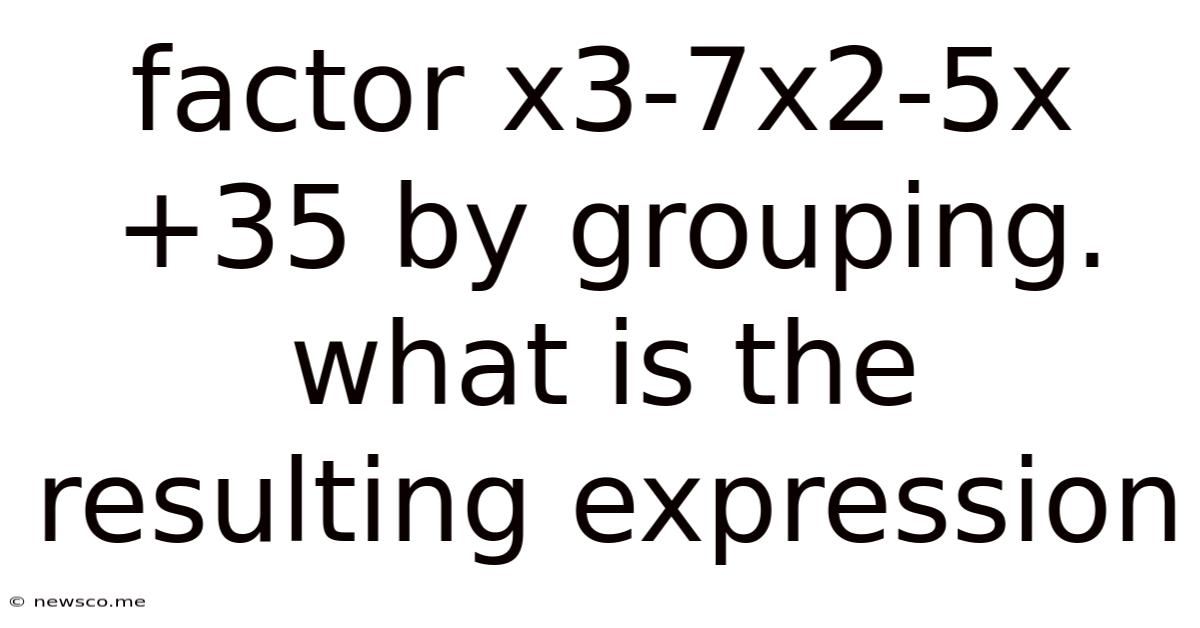Factor X3-7x2-5x+35 By Grouping. What Is The Resulting Expression
News Co
Mar 15, 2025 · 4 min read

Table of Contents
Factoring x³ - 7x² - 5x + 35 by Grouping: A Comprehensive Guide
Factoring polynomials is a fundamental skill in algebra. While many methods exist, factoring by grouping is particularly effective for polynomials with four or more terms. This article will delve into the process of factoring the cubic polynomial x³ - 7x² - 5x + 35 using the grouping method, explaining each step thoroughly and providing additional context and examples to solidify your understanding.
Understanding Factoring by Grouping
Factoring by grouping is a technique used to factor polynomials with an even number of terms by grouping terms with common factors. The goal is to manipulate the expression to reveal common binomial factors that can then be factored out. This method relies heavily on recognizing patterns and skillfully manipulating the terms. Let's break down the process step-by-step.
Step 1: Group the Terms
The first step involves grouping the polynomial's terms into pairs. For our polynomial, x³ - 7x² - 5x + 35, we group the terms as follows:
(x³ - 7x²) + (-5x + 35)
Notice how we've placed parentheses around each pair. The choice of grouping is crucial and often requires some intuition. We'll explore why this particular grouping works later.
Step 2: Factor Out the Greatest Common Factor (GCF) from Each Group
Next, we identify and factor out the greatest common factor from each group. Let's analyze each pair:
-
(x³ - 7x²): The greatest common factor of x³ and -7x² is x². Factoring this out gives us x²(x - 7).
-
(-5x + 35): The greatest common factor of -5x and 35 is -5. Factoring this out gives us -5(x - 7).
Therefore, after factoring out the GCF from each group, our expression becomes:
x²(x - 7) - 5(x - 7)
Step 3: Identify and Factor Out the Common Binomial Factor
Observe that both terms in the expression now share a common binomial factor: (x - 7). This is the key to successfully factoring by grouping. We can factor out this common binomial factor:
(x - 7)(x² - 5)
This is the factored form of our original polynomial, x³ - 7x² - 5x + 35.
Verifying the Result
To verify our factorization, we can expand the factored expression using the distributive property (often called FOIL for binomials):
(x - 7)(x² - 5) = x(x² - 5) - 7(x² - 5) = x³ - 5x - 7x² + 35 = x³ - 7x² - 5x + 35
This matches our original polynomial, confirming that our factorization is correct.
Why This Grouping Worked
You might be wondering why we grouped the terms the way we did. The success of factoring by grouping often hinges on choosing the correct grouping. If we had grouped the terms differently, for example, (x³ - 5x) + (-7x² + 35), we would not have found a common binomial factor. The key is to obtain a common binomial factor after factoring out the GCF from each pair. This often requires some trial and error, especially with more complex polynomials. Practice and experience improve your ability to anticipate the most effective grouping strategy.
Further Exploration: Factoring Other Polynomials
Let's extend our understanding by factoring other polynomials using the grouping method. Consider the polynomial 2a³ + 4a² + 3a + 6.
-
Group the Terms: (2a³ + 4a²) + (3a + 6)
-
Factor Out the GCF from Each Group: 2a²(a + 2) + 3(a + 2)
-
Factor Out the Common Binomial Factor: (a + 2)(2a² + 3)
Therefore, the factored form of 2a³ + 4a² + 3a + 6 is (a + 2)(2a² + 3). Again, we can verify this result by expanding the factored expression.
Another Example: Consider the polynomial 6x³ - 15x² - 4x + 10
-
Group the Terms: (6x³ - 15x²) + (-4x + 10)
-
Factor Out the GCF from Each Group: 3x²(2x - 5) + -2(2x - 5)
-
Factor Out the Common Binomial Factor: (2x-5)(3x² - 2)
Therefore, the factored form of 6x³ - 15x² - 4x + 10 is (2x-5)(3x² - 2).
Addressing Potential Challenges
While factoring by grouping is a powerful technique, it doesn't always work. Some polynomials may not be factorable using this method, requiring other techniques such as the quadratic formula or other advanced factorization methods. It's also important to note that the order of terms often matters. Experimentation and practice are key to mastering this skill.
Advanced Applications and Connections
Factoring by grouping isn't just a standalone technique; it connects to other crucial algebraic concepts. For example, understanding how to factor by grouping helps in solving cubic and higher-order equations. It also plays a vital role in simplifying rational expressions and performing partial fraction decomposition.
Conclusion: Mastering Factoring by Grouping
Factoring by grouping is a valuable tool in your algebraic arsenal. By understanding the steps involved and practicing regularly, you'll become proficient in applying this technique to a wide range of polynomial expressions. Remember the importance of identifying the greatest common factor, recognizing common binomial factors, and verifying your results through expansion. With consistent practice and a keen eye for patterns, you'll confidently tackle more complex factoring challenges. The ability to factor efficiently lays a solid foundation for success in more advanced mathematical endeavors. Mastering this skill will significantly enhance your problem-solving capabilities in algebra and beyond.
Latest Posts
Related Post
Thank you for visiting our website which covers about Factor X3-7x2-5x+35 By Grouping. What Is The Resulting Expression . We hope the information provided has been useful to you. Feel free to contact us if you have any questions or need further assistance. See you next time and don't miss to bookmark.